Past and Present: 951 Prospect Place, Back From the Dead
A look at Brooklyn, then and now. Most of the Past and Present pieces involve photographs of old buildings that are now either gone, replaced by something else, or transformed into something less than what they were. Here we have something different. This is a building that was pretty great to begin with, was totally…
A look at Brooklyn, then and now.
Most of the Past and Present pieces involve photographs of old buildings that are now either gone, replaced by something else, or transformed into something less than what they were.
Here we have something different. This is a building that was pretty great to begin with, was totally wrecked for a generation, but now is back, better than ever.
Number 951 Prospect Place was built as the standout corner building in a set of four, along Brooklyn Avenue, right across the street from one of Brooklyn’s prettiest small parks, Brower Park.
When developer Louis Meyer had these flats buildings built in 1906, this area was known throughout the city as the St. Marks District. A block away stood the huge, opulent mansions of some of Brooklyn’s wealthiest people.
The back windows of the three buildings facing Brooklyn Avenue would have looked over the estate of the Straus family, one of the partners in Abraham & Straus.
Single-family row houses for those less wealthy than the Strauses had been built on all of the surrounding streets. And by the early years of the 20th century, developers had begun building elegant flats and small apartment buildings around the park, taking advantage of all of the eager customers who wanted to live in this popular part of Brooklyn.
2015 photo by H. Drellich
One of the architects who designed many of the fine single-family row houses in the area was Axel Hedman. This Swedish-born architect was responsible for a great deal of the architecture that makes up today’s Crown Heights North.
Some of his finest houses can be found on St. Marks Avenue, across from the park, as well as on the next block of Park Place, between Brooklyn and New York Avenues. His work can also be found in Park Slope, Lefferts Manor, Prospect Heights and Bedford Stuyvesant/Stuyvesant Heights.
Hedman was an undisputed master of the Renaissance Revival style. This style was made popular after the Chicago World’s Exhibition that gave us the White Cities Movement, a move towards classical architecture, light-colored building materials and classical ornament.
He designed these flats using all of these elements. The buildings rise on a limestone base, with light grey bricks above. Limestone ornamental trim and decorative carved elements highlight the windows and entrances.
Hedman placed large pressed-metal cornices with embossed classical garlands on the wide cornice, with a deep bracketed overhang. Unfortunately, the three buildings on Brooklyn Avenue have had all of their cornices removed. It makes a big difference.
Because the corner building, 951 Prospect Place, was the most prominent, Hedman piled on the ornament on this wide expanse. The most notable elements are the twin dolphins flanking the columns of the second floor window above the building’s entrance.
Dolphins were symbols of welcome and hospitality, fine figures for a fine building. All of the buildings originally had eight large seven-room apartments, which stretched from the front to the back of the buildings, two on a floor, on either side of a central stairway.
2010 photo by Suzanne Spellen
The buildings were completed in 1907, and were quickly filled with upper-middle-class tenants. Help-wanted ads for servants begin appearing in the papers in 1909.
In 1913, a new management company began running a new ad for the buildings, with a photograph. Rents were $45 and $50 a month for the seven-room plus bathroom apartments. Amenities included steam heat, electric lights, parquet floors and “first class janitor services.”
Brooklyn Eagle, 1913
Over the years, tenants included Thomas Hewitt Vassar, a descendant of the founder of Vassar College. He and his wife and children were mentioned in the Brooklyn society pages in the early 1920s.
During World War II, one of the building’s tenants, Staff Sgt. T. J. Heller, was a waist-gunner aboard a B-17 that flew 50 missions over Europe.
Tragically, eight-year-old Roger Rush, living here at 951, was struck by a truck and killed on Nostrand Avenue in 1951. The ambulance didn’t arrive for an hour after the 4:30 p.m. accident, because there wasn’t one available. This accident helped change the city’s emergency response system.
The building went through a number of owners during the 1970s, with deteriorating conditions. Although Crown Heights was part of Central Brooklyn, which was thought by many to be one enormous slum called Bedford Stuyvesant, most of the blocks remained intact, with owner-occupants.
2010 photo by Suzanne Spellen
Apartment buildings didn’t fare as well as individual homes. In 1985, the city issued a vacate order for 951. It remained vacant and boarded up for the next 28 years.
Sometime in the 1990s the landlord put scaffolding up around the building, and that became part of the blight, as it rotted away too.
The surrounding blocks all had active block associations, and they, along with Community Board 8, lobbied the city to do something about the building. But since the owner, an LLC, paid his taxes, the city wasn’t inclined to do much but monitor the decay and issue fines.
In 2002, the Crown Heights North Association (CHNA) was founded by preservation-minded community members, some of whom lived within a stone’s throw of this building. The organization’s initial goal was to get Crown Heights North landmarked.
This building was a poster child for what could happen as desirable building stock was warehoused until the optimal time for development or sale. Right across from the Brooklyn Children’s Museum, this building was a disgraceful eyesore.
Phase I of the Crown Heights North Historic District was designated in 2007. This building and its neighbors were included. That year, the new Rafael Viñoly-designed Brooklyn Children’s Museum made its debut.
Since the building was now landmarked, CHNA asked the legal wing of the Landmarks Preservation Commission to investigate and put pressure on the owner. The building had further deteriorated, the scaffolding was in danger of falling, and the sidewalks underneath the scaffolding were dangerous. There were muddy craters and pieces of concrete sticking up, capable of tripping people.
The LPC wanted to charge the landlord with demolition by neglect. Letters were sent, and legal action was about to begin.
In October of 2012, Hurricane Sandy tore open the top floor and removed most of the roof. Debris fell onto the scaffolding and the street. But the rest of the building still stood.
2012 photo by H. Drellich
Work on the building finally began in June of 2013. The firm of Old Structures Engineering, PC took on the project, and the scaffolding went up.
When the tarps came down, the building emerged like a phoenix from the ashes. Everything was repaired, replaced and replicated. From the street, the building looks as good as it did the day Axel Hedman handed Louis Meyer the keys.
2015 photo by H. Drellich
The restorers replicated the cornice perfectly. They found the appropriately colored brick and repaired the Brooklyn Avenue side of the building. They replicated the keystones above the windows and restored all of Hedman’s beautiful ornament and detail.
2015 photo by H. Drellich
This is a perfect example of how we can bring our vacant and abused building stock back to life. Brooklyn’s neighborhoods are full of these small flats buildings, as well as larger apartment buildings, both walk-ups and elevator, many of which are in poor shape. It takes talent, and yes, it takes money, but look!
Old Structures Engineering did a fantastic job. It’s not often a Past and Present shows a “Present” being more beautiful and hopeful than a “Past.” Kudos. Please do more; there are quite a few buildings around that can use your help.
In the meantime, 951 Prospect Place is once again a building that the Crown Heights community can point to with pride. Once again, those dolphins are showing their hospitality.
2015 photo by H. Drellich

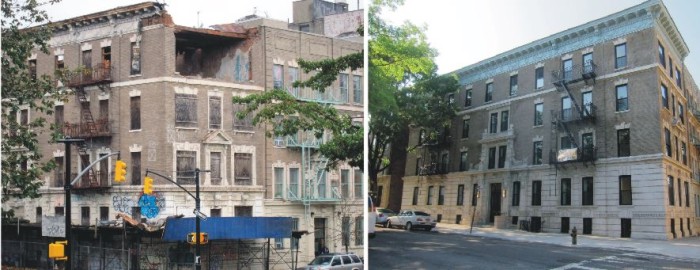
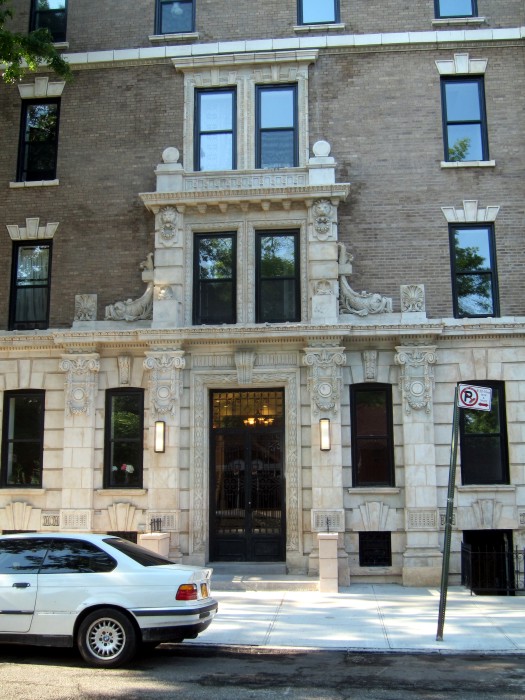

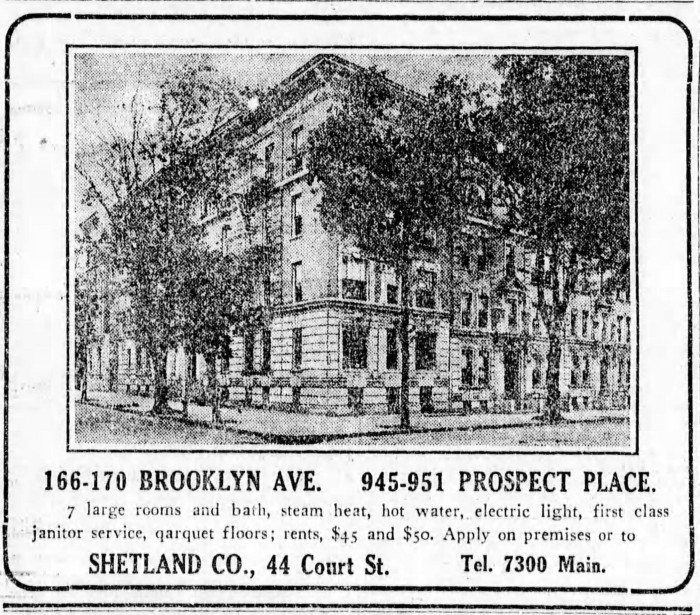
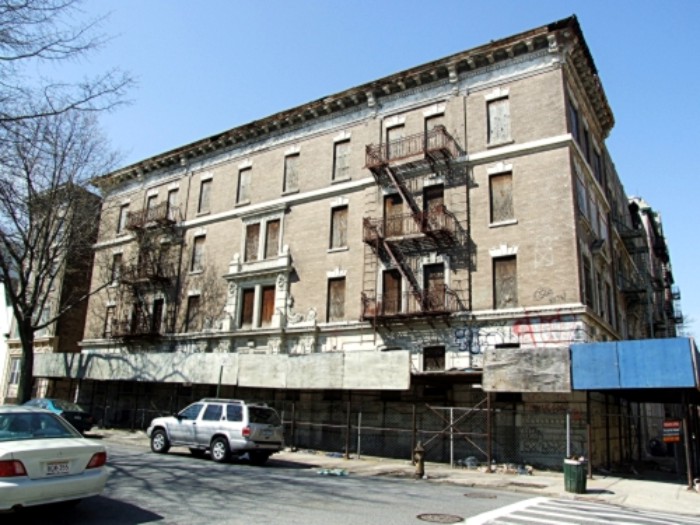
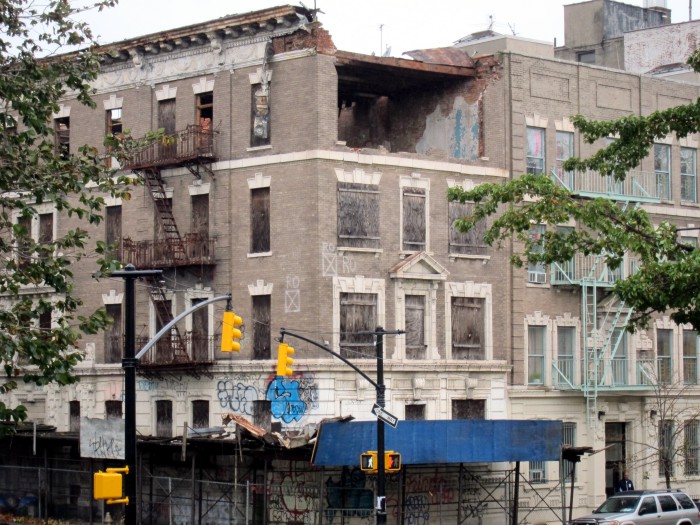
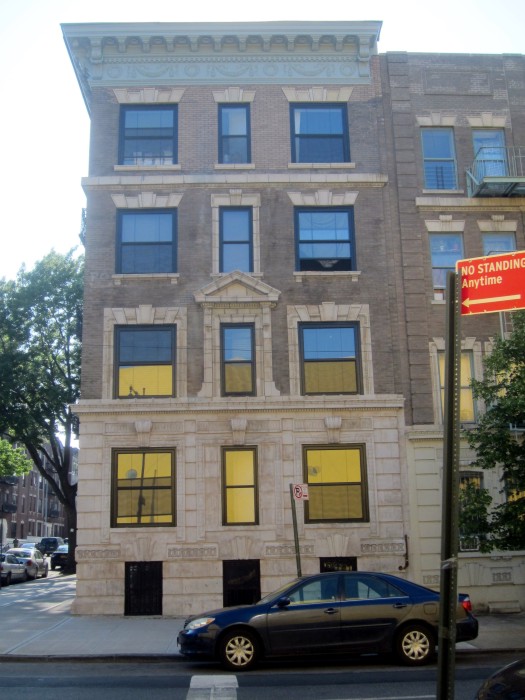
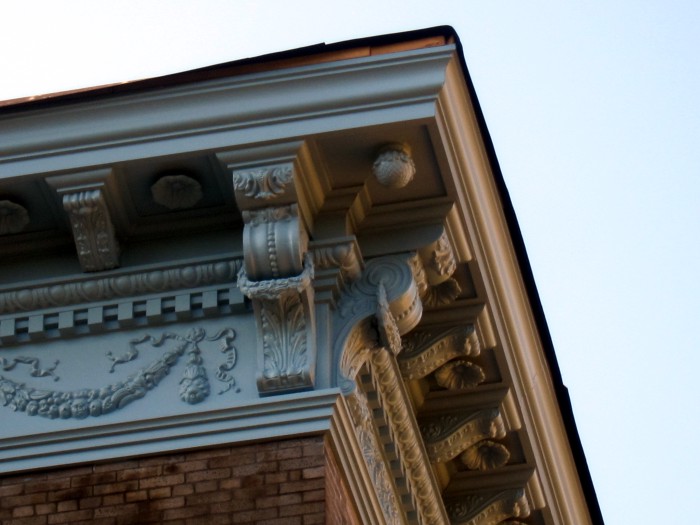





It’s awesome that the restoration of 951 Prospect Place has been featured in the Brownstoner with positive comments. However, there was no mention in the article of the Architect responsible for the design and specification of the exterior renovation. Michael Ivanhoe McCaw Architect, P.C. working with Preservationist John Graham of LPC and along with the following craftsmen (listed below) helped bring back 951 Prospect Place back from the dead.
For restoration of metal cornice:
CCR Sheet Metal Inc.
http://www.brownstoner.com/ccrsheetmetal
For masonry/stone repair and restoration:
Unique A1 Contracting Inc.
http://www.brownstoner.com/uniquea1contracting
For replication of decorative wrought iron entrance door and custom window security grilles:
Tio Iron Works
http://www.brownstoner.com/tioironworks
For Architectural Restoration:
Michael Ivanhoe McCaw Architect, P.C.
http://www.brownstoner.com/michaelivanhoe
Note: The Architect’s are also responsible for the restoration of 302 Stuyvesant Avenue:
http://www.brownstoner.com/blog/2015/03/retail-search-begins-at-turreted-building-in-stuy-heights-with-landmark-violations/
Amazing! I’ve never seen an everyday building so far gone get brought back so faithfully.
Great exterior Restoration. Thank God it was landmarked!
Fascinating, informative post. Love the dolphin!
Filled out the form and sent it in now!
To clarify: Old Structures designed temporary stabilization (for the “unsafe building” violation and during construction) and designed the reconstruction of the damaged and missing floors, roof, and structural portions of the masonry walls. We were not part of the architectural restoration.